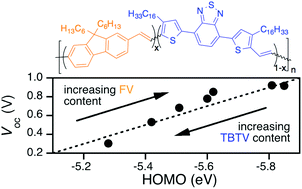Tuning of HOMO energy levels and open circuit voltages in solar cells based on statistical copolymers prepared by ADMET polymerization†
Abstract
A series of donor–acceptor statistical copolymers based on a 2,7-divinyl-9,9′-di-n-hexylfluorene (FV) donor and 4,7-bis(4-hexadecyl-5-propenyl-2-thienyl)-2,1,3-benzothiadiazole (TBTV) acceptor were prepared to investigate the relationship between copolymer donor–acceptor ratio and organic solar cell (OSC) performance. Homopolymers of the donor and acceptor moieties were prepared by acyclic diene metathesis (ADMET) methods. Five copolymers with systematically varied donor–acceptor ratios spanning the entire composition range were also prepared. All homopolymers and copolymers were characterized using size exclusion chromatography, nuclear magnetic resonance spectroscopy, ultraviolet-visible spectroscopy, and electrochemical cyclic voltammetry. Additionally, each polymer was incorporated into thin film field effect transistor and photovoltaic devices to investigate optoelectronic properties. The highest occupied molecular orbital (HOMO) level was found to be tunable over a 600 meV range through systematic variation of the copolymer donor–acceptor ratio. This same tunability manifested in the solar cell open circuit voltage (Voc), which also varied over a 600 mV range. Short circuit current density (Jsc) correlated well with field effect hole mobility. This series exemplifies the relationship between copolymer composition, HOMO energy level, and Voc, and demonstrates that peak solar cell performance can be achieved at non-stoichiometric donor–acceptor compositions.


 Please wait while we load your content...
Please wait while we load your content...